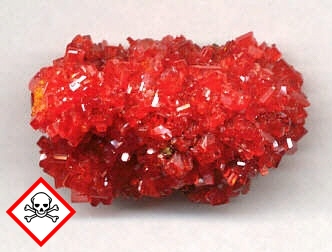Lopezite is a mineral containing the element chromium in a certain valence state (*), which is known to be particularly problematic when ingested or in contact with the human body and when released into the environment.
Chromium is required by the human body as an essential trace element. The toxicity of chromium depends on its valency (*): Chromium (III) compounds ("trivalent chromium") have low toxicity because they are poorly absorbed by the body. In contrast, chromium (VI) compounds ("hexavalent chromium") - especially when absorbed orally (through the mouth and nose) - have an extremely toxic effect. They are known to be carcinogenic and mutagenic and can cause inflammation of the eyes, skin and mucous membranes, as well as ulcers and eczema. A chronic course can lead to irreversible eye damage.
The chromium (VI) compound lopezite (potassium dichromate, K2Cr2O7) is usually available in the mineral trade in form of large, orange-colored crystal specimens that are grown artificially. In this form the mineral is very popular not only with children. The mineral is very soluble in water (1020 g/l). Contact can cause burns to the skin and mucous membranes, which is why it is classified as very toxic. Skin contact can also cause chromium allergies. There is a risk of serious eye damage. Inhalation of dust is carcinogenic and can cause hereditary damage.
Handling of Lopezite
When handling lopezite, it is essential to wear rubber gloves and a dust mask. Care should be taken not to rub eyes with contaminated fingers and not to eat or smoke while working. Lopezite should always be stored in airtight taped plastic boxes out of reach of children.
Lopezite is a powerful fire accelerant. Therefore, it should be kept away from flammable objects. In case of fire, the toxic fumes generated must be taken into account by wearing special protective clothing.
Because of their strong toxicity to aquatic organisms, all chromium (VI) compounds are classified as highly hazardous to water. Consequently, release into the environment must be avoided. If necessary, mineral specimens (including containers) should not be disposed of in the household waste, but as hazardous waste.
(*) Valence is a term from chemistry to describe the oxidation state, i.e. how many electrons a metal atom is missing to be chemically and electrically neutral or how many electrons a non-metal atom has too much to be neutral (uncharged).
read more on this topic:




